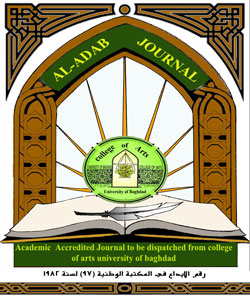Students' attitudes towards teacher performance Human rights
DOI:
https://doi.org/10.31973/aj.v0i129.581Keywords:
Human rights, democracyAbstract
The research aims to identify the attitudes of students towards the performance of the teacher of human rights and democracy through a special questionnaire applied to a sample of (70) students from the first phase of the academic year (2017-2018). The research found that the performance of the teacher of human rights and democracy was at the level Very high The research came out with a number of recommendations and suggestions.
Downloads
References
Abu Hatab Fouad and Others Psychological Evaluation, The Anglo-Egyptian Library, 1st Edition.
Al-Astal, Ibrahim, and Faryal Al-Khalidi, 2005, The Teaching Profession and the Roles of the Teacher in Al-Mustaqbal School, University Book House, Al-Ain, United Arab Emirates.
Al-Jafri, Ibtisam Hussein, 2002, the opinions of postgraduate students on the teaching performance of faculty members at Umm Al-Qura University, The Educational Magazine, Issue 64, Kuwait, p. 115.
Al-Sheikhi, Hashim Bin Saeed, 2015, discussing the role of the university professor in improving the quality of methods and methods of evaluating students, Journal of the Association of Arab Universities for Education and Psychology, the thirteenth Majd, the first issue.
Ashour, Ahmed Saqr, 1979, Manpower Administration, Arab Renaissance Publishing House, Beirut, 2nd floor.
Aziz, Hatem Jassim, 2012, Evaluation of the Performance of the Academic Staff at the University from the Students' Point of View (Field Study at Diyala University), Al-Fath Magazine, Issue Fifty, pg. 117 and beyond.
Hafez, and others, Abdel Nasser Allak, Nawal Tariq Ibrahim, Hussein Walid Hussein, 2015, Human Rights and Public Freedoms, Al-Sisban House, Association of Arab Universities for Education and Psychology, the thirteenth Majad, the first issue.
Hassan, Siddiq, 2012, Trends from a Sociology Perspective, Damascus University Journal, Volume 28, Issue (3 + 4), p.301.
Hassan, Siddiq, 2012, Trends in Sociology, Damascus University Journal, Volume 28, Issue (3 + 4).
Manasir, Hussein Jadou 'Mazloum, Al-Daini, Jabbar Rashk Shinawa, 2006, evaluation of the performance of a faculty member from the viewpoint of students of the Department of History, College of Education, Al-Qadisiyah Journal of Arts and Educational Sciences, Issue (1-2), Volume (7).
Paragraph (3) of Resolution (4/12) and the preamble of Resolution 15/11 issued by the Human Rights Council.
Shehata, Hassan and others, 2003, Dictionary of educational and psychological terms, The Egyptian House, First Edition, Cairo, p. 16.
The United Nations High Commissioner for Human Rights Report to assess the implementation of the second phase of the World Program for Human Rights Education on 6/16/2015.
The United Nations Program for Human Rights Education for the years (2010-2014).
The World Program for Human Rights Education, Phase Two, considers the action plan United Nations Educational, Scientific and Cultural Organization (1) The World Program for Human Rights Education, the second phase, considers the work plan of the United Nations Educational, Scientific and Cultural Organization.
Website of the Observatory for Human Rights Trainers in the Arab World http://www.hrtwaw.org/index.php?option=com_content&view=article&id=357:---, & catid = 42: 2010-03-07-09-25-29 & Itemid = 63 The United Nations Declaration for Education and Training in the Field of Human Rights Resolution No. (1/16) of March 23, 2011 Articles (2 and 3)
Zayer, Saad Ali Zayer, Dawood Abdel Salam Sabry and Muhammad Hadi Al-Shammari, Teaching Methods, Noor Al-Hassan Library.
Downloads
Published
Issue
Section
License
Copyright and Licensing:
For all articles published in Al-Adab journal, copyright is retained by the authors. Articles are licensed under an open access Creative Commons CC BY 4.0 license, meaning that anyone may download and read the paper for free. In addition, the article may be reused and quoted provided that the original published version is cited. These conditions allow for maximum use and exposure of the work.
Reproducing Published Material from other Publishers: It is absolutely essential that authors obtain permission to reproduce any published material (figures, schemes, tables or any extract of a text) which does not fall into the public domain, or for which they do not hold the copyright. Permission should be requested by the authors from the copyrightholder (usually the Publisher, please refer to the imprint of the individual publications to identify the copyrightholder).
Permission is required for: Your own works published by other Publishers and for which you did not retain copyright.
Substantial extracts from anyones' works or a series of works.
Use of Tables, Graphs, Charts, Schemes and Artworks if they are unaltered or slightly modified.
Photographs for which you do not hold copyright.
Permission is not required for: Reconstruction of your own table with data already published elsewhere. Please notice that in this case you must cite the source of the data in the form of either "Data from..." or "Adapted from...".
Reasonably short quotes are considered fair use and therefore do not require permission.
Graphs, Charts, Schemes and Artworks that are completely redrawn by the authors and significantly changed beyond recognition do not require permission.
Obtaining Permission
In order to avoid unnecessary delays in the publication process, you should start obtaining permissions as early as possible. If in any doubt about the copyright, apply for permission. Al-Adab Journal cannot publish material from other publications without permission.
The copyright holder may give you instructions on the form of acknowledgement to be followed; otherwise follow the style: "Reproduced with permission from [author], [book/journal title]; published by [publisher], [year].' at the end of the caption of the Table, Figure or Scheme.












